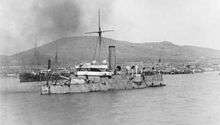Japanese gunboat Heien
Heien (Japanese: 平遠), originally known as Pingyuan (Chinese: 平遠; pinyin: Píngyuǎn), built by the Mawei Navy Yard near Foochow (Fuzhou), was an ironclad coastal battleship serving with the Imperial Chinese Beiyang Fleet and later the Imperial Japanese Navy. Previous transliterations of its Chinese name include Ping Yuen and Ping Yuan, also of its Japanese name Heiyen.
.jpg) Heien | |
| History | |
|---|---|
| Name: | Pingyuan |
| Builder: | Foochow Arsenal, Mawei, China |
| Yard number: | 29 |
| Launched: | 29 January 1888 |
| Completed: | 1890 |
| Fate: | Captured by Japan, 17 February 1895 |
| Name: |
|
| Acquired: | 17 February 1895 |
| Fate: | Mined off Pigeon Bay (Piegen Bay) west of Port Arthur, 18 September 1904 |
| General characteristics | |
| Displacement: | 2,150 long tons (2,185 t) |
| Length: | 60.96 m (200 ft) w/l |
| Beam: | 12.19 m (40 ft) |
| Draft: | 4.19 m (13 ft 9 in) |
| Propulsion: |
|
| Speed: | 10.5 knots (12.1 mph; 19.4 km/h) |
| Complement: | 202 |
| Armament: |
|
| Armor: |
|
Service record
Beiyang Fleet

As part of the Beiyang Fleet, Pingyuan was at the Battle of the Yellow Sea/Yalu River during the First Sino-Japanese War.[1] It was a Chinese armored cruiser built by the Mawei Navy Yard, modelled on the French Acheron-class gunboat. Pingyuan was firstly named Longwei (Chinese: 龍威; pinyin: Lóngwēi), and was the first Chinese-built ironclad, though some of its components were imported from abroad. Pingyuan was part of the Beiyang Fleet.
Pingyuan fought in the Battle of the Yalu River,[1] damaging the Japanese flagship Matsushima, and was later captured as a prize of war in the siege of Weihaiwei.
Imperial Japanese Navy
After its capture in February 1895, by the Imperial Japanese Navy, Pingyuan was placed into active combat service as the Pingyuan-go on 16 March 1895 and served with the Japanese fleet through the remainder of the First Sino-Japanese War. On 21 March 1898, she was re-designated as a first-class gunboat and was officially renamed Heien in 1900 based on the Japanese language pronunciation of its original Chinese name.
During the Russo-Japanese War, Heien was assigned to the 3rd Squadron and was part of the blockading force against the Imperial Russian Navy at the Battle of Port Arthur. Heien was disabled by a naval mine at Pigeon Bay (Piegen Bay), located to the west of Port Arthur on 18 September 1904 and foundered in heavy weather later that day. It was struck from the navy list on 21 May 1905.
References
- Notes
- Perry, John Curtis (1964). "The Battle off the Tayang, 17 September 1894". The Mariner's Mirror. 50 (4): 243–259. doi:10.1080/00253359.1964.10657787.
- Sources
- Wright, Richard N. J., The Chinese Steam Navy 1862-1945, Chatham Publishing, London, 2000, ISBN 1-86176-144-9
- Corbett, Sir Julian. Maritime Operations In The Russo-Japanese War 1904-1905. (1994) Originally classified, and in two volumes, ISBN 1-55750-129-7
- Chesneau, Roger and Eugene M. Kolesnik (editors), All The World's Fighting Ships 1860-1905, Conway Maritime Press, 1979 reprinted 2002, ISBN 0-85177-133-5
- Jentsura, Hansgeorg (1976). Warships of the Imperial Japanese Navy, 1869-1945. Naval Institute Press. ISBN 978-0-87021-893-4.
- Chen, Yue (2013b). Zhōngguójūnjiàntúzhì 1855-1911 中國軍艦圖誌1855-1911 [Album of Chinese Warships 1855-1911] (in Chinese). Hong Kong: The Commercial Press (Hong Kong). ISBN 9789620703614.CS1 maint: ref=harv (link)
External links
- Nishida, Hiroshi. "Materials of IJN". Imperial Japanese Navy. Retrieved 2007-09-03.